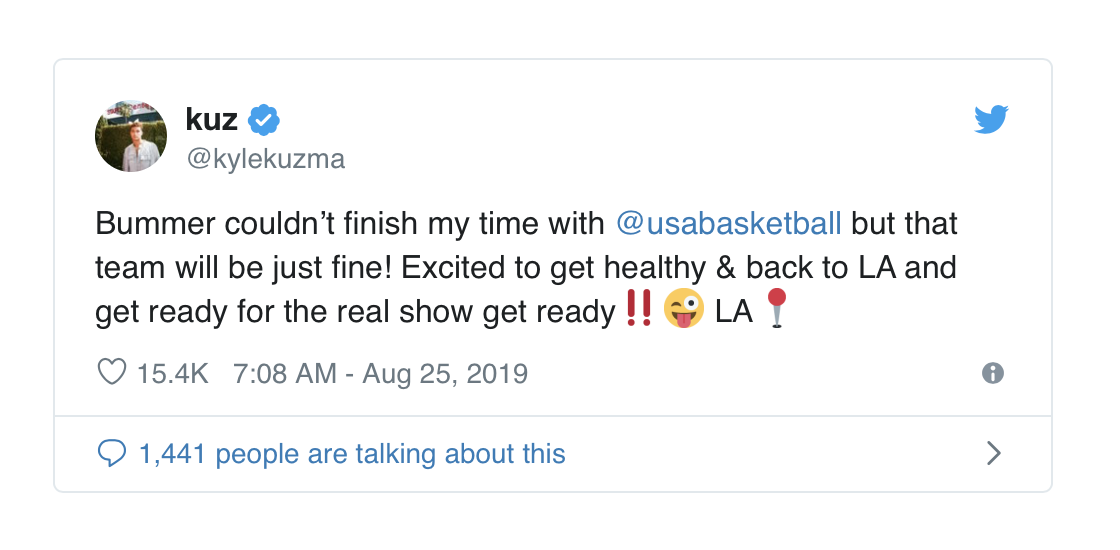New Look Los Angeles Lakers Have Another Setback

The Los Angeles Lakers expect young standout forward Kyle Kuzma to miss the start of training camp September 28th due to a left ankle injury. This report is from Marc Stein of the New York Times.
Ankle injuries in the off-season can be tricky to manage, as you want to be at or near full strength heading into the long marathon schedule- that is the NBA regular season. This is particularly going to come under careful management by the team trainers and physical therapists as the Lakers have all the makings of a team that will be playing well into June this season!
Kuzma suffered the injury while wearing the red, white, and blue during a pre-2019 FIBA World Cup exhibition.
Career and Outlook
The Lakers took Kuzma 27th overall in 2017, he has become an increasingly important player for the Lakers front court. Last year, Kyle averaged a career-high 18.7 points on 45.6 percent shooting and 5.5 rebounds. His quality production made the 24-year-old the lone untouchable in off-season roster moves.
Los Angeles Lakers coach Frank Vogel has high expectations for the third-year player this season, adding "Kuzma is a 10 out of 10 attitude and worker, and just a guy that's going to be an ass kicker for us this year," Vogel said during a recent interview with Lakers.com's Mike Trudell.
The Lakers' first regular-season game is Oct. 22 against Staples Center rival the Los Angeles Clippers.

More on Ankle Injuries?
The most common ankle injury is the ATF. This accounts for the majority of ankle sprains in sports and regular life too. Some estimate it is about 75% of all lower leg injuries. It involves “rolling” your foot to the inside.
The ankle joint is formed where the foot and the leg meet. The ankle, or talocrural joint, is a synovial hinge joint that connects the ends of the tibia and fibula (shin bones) in the lower limb with the proximal end of the talus bone in the foot. The joint between the tibia and the talus bears the vast majority of the body's weight while the fibula keeps the talus under the tibia.
The term "ankle" is used to describe structures in the region of the ankle joint proper. The joint under the ankle allows side to side movement while the ankle joint proper allows the foot to hinge up and down. Together they allow the foot to move as it were connected to the leg with a ball joint. Listed below are some of the most common pathologies written by our staff and local physicians that we see.
A common musculoskeletal injury in which the ligaments of the ankle are stretched, partially torn, or completely torn due to sudden over stretching. This most often occurs when the ankle is suddenly "twisted" in a sports activity or by stepping off an uneven surface. Most ankle sprains involve the ligaments on the outside of the ankle as the foot folds underneath the body. This is referred to as an inversion mechanism. Ankle sprains are very common in sports involving rapid side to side movements ("cutting"), such as basketball, soccer, and tennis.
SPRAINS ARE GRADED BASED ON THE EXTENT OF THE DAMAGE TO THE LIGAMENT.
- Grade 1 Sprain: An injury without macroscopic tears. No mechanical instability is noted. Pain and tenderness is minimal.
- Grade 2 Sprain: A partial tear. Moderate pain and tenderness is present. Mild to moderate joint instability may be present.
- Grade 3 Sprain: A complete tear. Severe pain and tenderness, inability to bear weight, and significant joint instability are noted.
TREATMENT:
R.I.C.E – Rest, Ice, Compression, Elevation. The best first step to this injury before you can see a doctor or physical therapist. Depending on the severity of the sprain, you might or might not even be able to walk without pain, so the best thing to do is stay off the injury as much as possible, and see a doctor immediately for evaluation.
Once in physical therapy, common first stages of treatment are to restore your basic range of motion and reduce swelling, begin a strengthening regimen, normalize gait (walking pattern), and then begin a return to normal activities. Only after success in all these stages are patients ready to begin agility and plyometric exercises and activities that begin to mimic game and competition.
Other Athlete Injury articles:
Todd Gurley, Los Angeles Rams running back has been haunted by injuries and rumors.
Kevin Durant, Golden State Warriors star suffers career setback with achilles tear.
Andrew Luck, Stanford Alum recovers from a mysterious ankle injury.
Demarcus “Boogie” Cousins, ACL Tear with LA Lakers.


